
Architecture Civil Engineering Environment
Scope & Guideline
Pioneering Research at the Intersection of Design and Sustainability
Introduction
Aims and Scopes
- Sustainable Architecture and Urban Design:
Research in this area emphasizes the integration of sustainability principles in architectural design and urban planning. It explores innovative materials, energy-efficient designs, and adaptive reuse of buildings to minimize environmental footprints. - Environmental Impact and Management:
This scope covers studies related to environmental assessments, pollution management, and the impact of urban development on natural ecosystems. It includes methodologies for evaluating air quality, waste management practices, and the resilience of urban infrastructures. - Human-Centric Design:
Research focusing on how architectural spaces influence human wellbeing and social interactions. This includes studies on the psychological effects of urban environments, accessibility for disabled persons, and child-friendly urban spaces. - Innovative Construction Techniques:
Explores cutting-edge construction methods and materials, including the use of recycled materials, smart technologies in building design, and structural reliability assessments to enhance the performance of built environments. - Climate Adaptation and Resilience:
Investigates strategies for adapting urban areas to climate change, including studies on stormwater management, heat mitigation, and the development of resilient urban infrastructures. - Cultural Heritage and Conservation:
Focuses on the preservation and restoration of historical buildings and urban areas, analyzing the balance between modern development needs and the conservation of cultural heritage.
Trending and Emerging
- Green Infrastructure and Urban Ecology:
An increasing number of studies focus on integrating greenery and ecological principles into urban environments. This includes research on biophilic design, green roofs, and urban biodiversity, reflecting a growing awareness of the benefits of nature in urban settings. - Smart Technologies in Building Design:
There is a notable trend towards the incorporation of smart technologies and IoT (Internet of Things) in building management and design. Research is exploring how technology can enhance energy efficiency, optimize resource use, and improve occupant comfort. - Health and Wellbeing in Architecture:
A significant emphasis is being placed on how architectural design influences the health and wellbeing of occupants. This includes studies on daylighting, ventilation, and spatial design that promote mental and physical health. - Climate Change Mitigation Strategies:
Research is increasingly focused on strategies for mitigating climate change effects, such as carbon neutrality in construction and innovative waste management practices. This is crucial as urban areas strive to reduce their carbon footprints. - Resilience and Adaptation in Urban Planning:
Emerging themes include resilience planning and adaptation strategies in the face of climate change. This encompasses research on disaster preparedness, sustainable urban drainage systems, and adaptable infrastructure.
Declining or Waning
- Traditional Urban Planning Models:
Research that adheres strictly to classical urban planning principles seems to be waning. The trend is moving towards more dynamic, participatory, and adaptable planning frameworks that respond to real-time urban needs. - Conventional Construction Materials:
There is a noticeable decrease in studies solely focused on traditional building materials without consideration for sustainability or innovation. The field is increasingly prioritizing research on eco-friendly and alternative materials. - Static Structural Analysis:
Research that relies heavily on static analysis methods without incorporating modern computational techniques or considering dynamic environmental factors is becoming less frequent. The focus is shifting towards more comprehensive analysis methods that account for variability and uncertainty. - Single-Dimensional Environmental Studies:
Studies that examine environmental issues in isolation, without a multidisciplinary approach, are declining. There is a growing recognition of the need for integrated studies that connect environmental, architectural, and engineering perspectives. - Historical Architectural Styles:
While culturally significant, research dedicated solely to historical architectural styles without linking to contemporary challenges or applications is diminishing. The focus is shifting towards how historical elements can inform modern design practices.
Similar Journals

Civil Engineering Journal-Tehran
Pioneering Research in Civil Engineering and Construction Excellence.Civil Engineering Journal-Tehran is a premier academic publication focusing on the dynamic fields of civil engineering, construction, and environmental science. Published by C EJ PUBLISHING GROUP, this journal has garnered significant recognition, reflected in its impressive quartile rankings—ranking Q1 in Building and Construction and Civil and Structural Engineering, and Q2 in Environmental and Geotechnical Engineering. With its ISSN 2676-6957 and E-ISSN 2476-3055, this journal serves as a crucial platform for disseminating innovative research and advancements from 2019 through 2024. Notably situated at K N Toosi University of Technology in Tehran, Iran, it emphasizes both local and global perspectives on civil engineering challenges. Aiming to foster scholarly discourse, the journal is essential for researchers, students, and professionals dedicated to the evolution and sustainability of civil engineering practices.

Electronic Journal of the Faculty of Civil Engineering Osijek-e-GFOS
Fostering Collaboration Through Open Access ResearchWelcome to the Electronic Journal of the Faculty of Civil Engineering Osijek-e-GFOS, a prominent platform dedicated to the dissemination of innovative research in the field of civil engineering. Published by the University of Osijek, this Open Access journal has been accessible to the global academic community since 2010, facilitating the sharing of knowledge and advancements without financial barriers. With an E-ISSN of 1847-8948, the journal aims to cover a broad scope of civil engineering disciplines, including structural engineering, geotechnics, environmental engineering, and construction management, among others. It serves as a crucial resource for researchers, professionals, and students, providing them with insightful articles and studies that contribute to the development of best practices in the field. By promoting open collaboration and knowledge sharing, the Electronic Journal of the Faculty of Civil Engineering Osijek-e-GFOS stands as a testament to the commitment of the University of Osijek to enhance the field of civil engineering through impactful research and educational outreach.

ICONARP International Journal of Architecture and Planning
Advancing innovative solutions in architecture and urban design.ICONARP International Journal of Architecture and Planning is an esteemed open-access publication that serves as a pivotal platform for fostering innovative research and discussions in the fields of architecture and urban design. Published by KONYA TECHNICAL UNIVERSITY, FACULTY OF ARCHITECTURE & DESIGN, this journal has been committed to the dissemination of high-quality academic work since 2013, promoting accessibility and global collaboration among researchers, professionals, and students. With its rigorous peer-review process and a focus on contemporary architectural and planning challenges, ICONARP seeks to contribute significantly to scholarly discourse and practical applications within the built environment. The journal is indexed in various scientific databases, enhancing its visibility and impact in the academic community. By appealing to a diverse audience, ICONARP encourages interdisciplinary studies and innovative solutions that address the complexities of modern architecture and urban living.
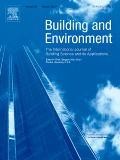
BUILDING AND ENVIRONMENT
Innovating the intersection of architecture and ecology.BUILDING AND ENVIRONMENT, published by Pergamon-Elsevier Science Ltd, stands as a premier journal in the fields of Building and Construction, Civil and Structural Engineering, Environmental Engineering, and Geography, Planning, and Development. With its ISSN 0360-1323 and E-ISSN 1873-684X, this esteemed publication has garnered significant acclaim, achieving a Q1 ranking in multiple categories for 2023, reflecting its influential role in advancing research and innovation within these domains. Spanning from 1976 to 2024, the journal invites contributions that explore the intersection of sustainable design, energy efficiency, and urban development, addressing critical issues faced in modern architecture and environmental impact. Although it does not offer open access, its comprehensive articles and reviews are pivotal for researchers, professionals, and students dedicated to creating sustainable built environments. Situated in the United Kingdom, the journal serves as a vital resource for those aiming to contribute to the knowledge base in this rapidly evolving ecologically focused field.

Advances in Civil and Architectural Engineering
Innovating Tomorrow's Infrastructure TodayAdvances in Civil and Architectural Engineering is a cutting-edge scholarly journal dedicated to the dissemination of pioneering research in the realm of civil engineering and architecture. Published by the esteemed Josip Juraj Strossmayer University of Osijek, Faculty of Civil Engineering and Architecture, this journal operates under an Open Access model since 2022, allowing for unrestricted access to its rich repository of articles. The journal aims to bridge the gap between academia and industry by providing a platform for innovative studies, technical advancements, and best practices that contribute to the evolution of sustainable construction and architectural design. With its focus on interdisciplinary approaches and contemporary challenges in the field, Advances in Civil and Architectural Engineering serves as an invaluable resource for researchers, professionals, and students seeking to enhance their understanding and impact in this vital area of engineering. The journal's ISSN is 2975-3848, and it is committed to fostering the advancement of knowledge and collaboration within the global engineering community.
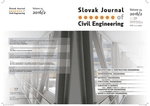
Slovak Journal of Civil Engineering
Connecting researchers to the future of civil engineering.Welcome to the Slovak Journal of Civil Engineering, a premier open-access publication dedicated to advancing the field of civil engineering. Published by SCIENDO, this journal has been providing a platform for the dissemination of groundbreaking research since 2010, ensuring that all articles are freely accessible to a global audience. With a commitment to promoting innovation and excellence within civil engineering, the journal covers a wide range of topics, including structural engineering, transportation systems, geotechnics, and environmental engineering. The Slovak Journal of Civil Engineering is designed to engage a diverse community of researchers, professionals, and students, fostering collaboration and knowledge-sharing to address contemporary challenges in the field. With its open-access model, the journal not only enhances visibility for authors but also ensures that the latest findings and methodologies reach practitioners and academics alike, making it an essential resource for anyone interested in civil engineering advancements. Stay connected with the evolving landscape of civil engineering through this influential publication.
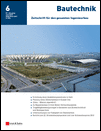
Bautechnik
Exploring the forefront of building technology and methodologies.Bautechnik is a premier academic journal in the fields of Building and Construction and Civil and Structural Engineering, published by ERNST & SOHN in Germany. With a history dating back to 1969 and a significant converged timeline through various years, this journal offers a rich repository of peer-reviewed research dedicated to advancing the principles, methodologies, and innovations within its domains. Bautechnik is currently ranked in the Q3 category for both building and construction, as well as civil and structural engineering, indicating its relevance and contribution to the academic community. Though it does not offer open access, its curated content is accessible to a global audience of researchers, professionals, and students striving for excellence in their fields. The journal aims to foster discussions and disseminate knowledge that impacts the future of construction, architecture, and engineering practices.
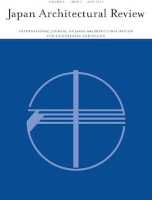
Japan Architectural Review
Navigating trends and challenges in modern architecture.Japan Architectural Review is a premier open-access journal published by WILEY, dedicated to advancing the fields of architecture, environmental engineering, and modeling and simulation. Since its inception, this journal has emerged as a critical platform for disseminating innovative research, offering insights into the latest trends and challenges facing the built environment and sustainability practices. With an impact factor reflecting its growing influence, especially in the Q2 category of Architecture and notable rankings in environmental engineering and modeling disciplines, it serves as an essential resource for researchers, professionals, and students alike. The journal's commitment to open access since 2018 has further enhanced its reach, making high-quality research accessible to a global audience. Spanning an important timeline from 2019 to 2024, the Japan Architectural Review facilitates a collaborative discourse among scholars, encouraging innovative solutions to contemporary architectural challenges.

Techne-Journal of Technology for Architecture and Environment
Bridging Innovation and Sustainability in ArchitectureTechne - Journal of Technology for Architecture and Environment, published by FIRENZE UNIV PRESS, is an important academic platform that bridges the gap between technology and architecture while addressing the evolving environmental challenges of our time. Established in 2015, this journal provides a forum for innovative research and discussions that critically examine the intersections of architecture, urban studies, and construction engineering. With an impact factor indicative of growing recognition in its field, Techne encompasses a broad spectrum of studies, marking its presence in the Q3 and Q4 quartiles across various categories, including Architecture, Building and Construction, Education, and Health (Social Science). The journal is indexed in Scopus with varying ranks, showcasing its increasing relevance and influence among contemporary literature. Although it operates under a non-open access model, the journal ensures that its scholarly contributions are accessible through institutional connections, making it a vital resource for researchers, professionals, and students seeking to advance their knowledge on the integration of technology in shaping sustainable architectural practices.
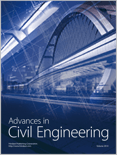
Advances in Civil Engineering
Unlocking the Future of Structural InnovationAdvances in Civil Engineering is a leading peer-reviewed journal published by HINDAWI LTD, dedicated to advancing knowledge and innovation in the field of civil and structural engineering. Holding an esteemed Q2 ranking in the 2023 category for Civil and Structural Engineering, this journal serves as a vital platform for disseminating cutting-edge research and practical applications that address contemporary challenges in infrastructure development, sustainable design, and material science. Launched in 2008 and operating as an Open Access journal since 2009, it promotes the free exchange of ideas by ensuring that all articles are accessible to researchers, professionals, and students globally. The journal is also indexed in Scopus, ranking at #142 out of 379 in its category, situating it within the 62nd percentile of its peers. With a focus on interdisciplinary collaboration and innovative solutions, Advances in Civil Engineering contributes significantly to the ongoing evolution of engineering practices and education, making it an essential resource for anyone involved in or studying the ever-evolving field of civil engineering.